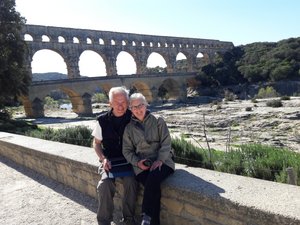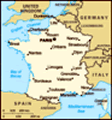Advertisement
Published: April 1st 2019

 At the Pont du Gard
At the Pont du Gard
We had just crossed over the Pont using the water channel on the top level. When we were in Montpellier two years ago we traveled to Nîmes. We thought we could do the town and the Pont du Gard (the famous aqueduct that brought water to Nîmes) in one day. Then we discovered how far it was from Nîmes to the Pont. We did the town and regretted our inability to see the aqueduct. If you are interested in our previous experience in the town, click
https://www.travelblog.org/Europe/France/Languedoc-Roussillon/N-mes/blog-974056.html]here. I did and it brought back some great memories.
The Roman museum in Nîmes Nîmes was everything we remembered. As soon as you exit the train station you find yourself walking up this incredibly wide mall lined with trees and benches. A few blocks into town you come to the amazing amphitheatre which in many ways is more impressive than the Coliseum in Rome (see previous blog). It has another expanse of open area around it including cafés, one of which we had visited before. And again this trip. Across the street was the new museum.
Since we had seen most of the town, we concentrated on this new museum which hadn’t been completed when we were there in 2017. It is stunning. The statues, mosaics

 Now that's a coffee break!
Now that's a coffee break!
Mine is the lowly cappuccino on the right.and other displays were impressive. But what interested me even more was the information about the Pont du Gard and the rest of the aqueduct. The Pont du Gard is impressive: 390 metres long, 49 metres tall (highest in the Roman world) and it took 1,000 men 5 years to build it. But what I had not thought about was that the aqueduct is more than this amazing structure. It brought 40,000 cu. ft. of water each day to the town 50 kilometers away. It was underground over 90 percent of the way. It had a total of 19 overhead structures of which the Pont du Gard was merely the most impressive. Many of the items in the museum were found when they were excavating to build the underground parking garages which are under some of the beautiful open spaces in the town.
After our visit, we had some time to stroll around town, revisiting the beautiful walkways, canals and the structures in the town. Nîmes is definitely worth a day (or more) of your time in France.
Pont du Gard A few days later, because of the nuisance of getting from Montpellier to the Pont

 Nîmes amphitheatre
Nîmes amphitheatre
Across he street from the café and the Musée. You could spend most of a day in there. The displays were great when we visited in 2017.by train and bus, we decided ask our new friend, Isabelle (who had driven us to St Guilhem le Désert) if she had a tour to the Pont. Well, she didn’t have one specifically for that but, for us, she would make one. She picked us up right at our door step and we drove to the town of Uzès near the source of the water for the Nîmes aqueduct. We toured the town and the fortifications, and saw some of the old waterworks relating to the aqueduct. It was interesting to see this sort of thing in an unrestored condition. Lunch followed in a very nice restaurant. It was so popular that all the tables outside in the square were taken. That was actually a good thing because there was a small hurricane blowing and it would have been a bit chilly out there.
Off to the Pont which is about 20 kilometers away. It’s in the middle of nowhere but the parking lot is huge because of the crowds that come in the summer. Fortunately, it wasn’t summer. Isabelle had booked us for the 2:30 tour which was in English. About 15 hardy souls braved the very

 New Musée
New Musée
The new museum from the delightful garden in back when we had our lunch.strong winds to hike the short distance to the starting point. There we got a brief history of the building of the Pont and the “modern” bridge beside it. Luckily we were able to find a spot which minimized the wind because the tour guide had to deliver her spiel in English and then again in French. Once was OK, twice was a bit chilly.
The “tour” wasn’t really anything we couldn’t have learned by reading the excellent materials or studying beforehand on the internet. However, it did include walking across the Pont on the upper level where the water used to run. This involved ducking your head to walk under the capstones some of which are still in place. And turning sideways at times to get by the limestone deposits that over the years settled on the sides of the waterway. These had to be cleaned off as they gradually restricted the flow of water. Not sure how they did that. Must investigate further. The extra special feature of this part of the tour is that this may be the last year people are allowed to walk across the Pont. If that is the case, we were very

 Top of a column
Top of a column
The detail in these things is amazing. When you consider how many of the columns were around, it is even more amazing.lucky.
This walk made taking the tour completely worthwhile. But, boy, was it windy. As you can see from the pictures, the watercourse was quite deep so there was no danger of getting blown off; but it was close. The tour ended as soon as we got to the other side. We were then free to wander around as we saw fit. The way back to the car allowed us to walk across the “modern” bridge. It was built in the mid-1700s! The guide had told us the original aqueduct took five years to build in the first century A.D. and the “modern” bridge also took five years to build using basically the same technology. Those Romans were really something.
After the outside visit we got to watch a great film which used drones to fly down the complete 50 km path of the aqueduct. It included some great animation on how it was built with subtitles in multiple languages. The movie was in a huge theatre which I am sure would be packed in the summer. The rest of the building contained a fabulous museum, one of the best I have ever seen. It didn’t have audio

 Detail descriptions
Detail descriptions
Sometimes they tell you more than you want to know.guides but most of the displays had plaques in four languages. Huge displays demonstrated how they cut, shaped, moved and combined gigantic limestone blocks into the beautiful Pont du Gard. They even had hands-on display for the kids (and the kids at heart; my bridge didn’t fall down).
Isabelle got us home safe and sound after a fabulous day. This was in spite of the gale force winds on our little car.
We could easily have spent the whole day simply at the Pont du Gard. That would have meant not seeing the sources of the water supply which we found very interesting.
Now what? The day after we came home from the Pont du Gard we planned on busing to view the aqueduct of Castries which is practically in Montpelllier. Apparently we haven’t had enough of aqueducts. This turned out to be more of an adventure than we had planned. ToBeContinued!
Advertisement
Tot: 0.902s; Tpl: 0.028s; cc: 22; qc: 75; dbt: 0.4635s; 1; m:domysql w:travelblog (10.17.0.13); sld: 1;
; mem: 1.3mb

























